Positions In Dota 2
Positions in DOTA 2 are number from 1 to 5 describing each role’s farm priority in any given team. While exceptions are plenty they generally follow the same structure with the pos1 having the highest farm priority, while the pos5 generally doesn’t spend much time farming at all.
Like in any other game, Heroes in DOTA 2 can be classified into specific roles based on their abilities and possible play styles. We will discuss their distinct differences, strengths, weaknesses as well each role’s overall job in any game of DOTA 2. This guide will explain the roles system in its current iteration and benefits of “maining” a role with it’s appropriate pros and cons. You will learn which hero choices are ideal and how you can make the most out of them by playing your role to the fullest.
An easy way of remembering the roles can be seen in the following table.
| Position 1 | Safe lane core (carry) | Scales extremely well with farm. Usually right click physical damage dealers.
|
| Position 2 | Mid lane core | Sets the tempo for the early to mid game, scales well with farm. Usually magic damage heroes, often with some form of wave clearing ability.
|
| Position 3 | Off lane core | Utility core (initiation, auras, front line tank,etc.) Scales well with farm, gains farm in the dangerous parts of the map.
|
| Position 4 | Soft support (roam) | Offers help to other lanes, applies aggression in the early game.
|
| Position 5 | Hard support | “Babysits” the position 1, makes sure he has as good a game as possible. Uses resources for “support” items, e.g. Wards, Dust, Smoke, Gem, etc.
|
The idea here is to put a number (from 1 to 5) on a hero based on his/her farming priority scale. 1 is for heroes that require the utmost priority in farming, while 5 is mainly focused on providing support (e.g. warding, dewarding, courier, support items, etc.). In some cases, 4 and 5 can be the same, although they differ in terms of which hero should focus on warding, among others.
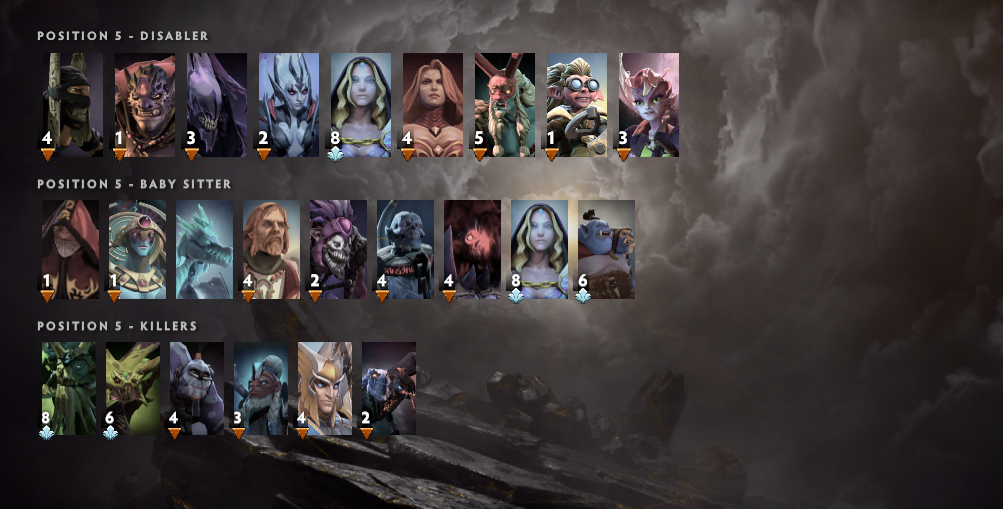
Position 5 – Support
Common Heroes: Shadow Shaman, Lion, Crystal maiden, Ogre Magi, Winter Wyvern
These heroes will often be first picked into the draft. Thus, they should be strong and well-rounded heroes. Typically, with some type of disable, most commonly a stun, but some have slows or roots.
This hero position is responsible for giving the carry the much-needed space to level up and farm. By pulling lane creeps into the jungle camps you can easily shift the lane equilibrium to your favour. Trading hits with the offlaner is also important. As each lane composition is unique, it’s important to adapt your plan to fit the specific lane circumstances.
The position 5 does NOT spend his time farming waves and creep camps, but rather has to keep his focus on the map as a whole. If you are playing this position, it is your job to maintain an overview of the map, and to strategically approach it. When your teammates are getting chased under their towers (i.e. the enemy is “overextending”) you should generally be the first one to respond. Ideally, you will be ready to react and may not only save your ally, but also punish the opponent.
This can be done by either knowing how certain matchups work (Monkey King, Queen of Pain, Spirit Breaker will often dive under your towers), or being aware of enemy movements (if a ganking hero is missing, he is most likely about to jump someone soon).
Since warding and properly placing vision are a huge part of any support player’s game, we have prepared guides on placing vision as well as supporting in a broader sense.
Spend money to make money
Supports gain gold in a completely different way from cores. In slow games, most of your gold will be from the Periodic gold you passively gain. Hence, you will consistently be getting 1 gold ever 0.7 seconds, or rather, 85 gold every minute. In slow games you will also be gaining gold from stacking creep camps. When a stacked creep camp is farmed by another hero, you will gain 35% of whatever the allied hero farming the stack gets.
Most of the position 5 Support’s gold will be going towards cost efficient items, such as consumable healing items (salves, clarities, mangoes), wards, cheap stat items (bracer, Magic Wand) or some form of saving ability item (Glimmer cape, Force Staff, E-blade).
In more active games, you will also be getting gold from Kills, assists and de-warding the enemy observer wards. While it’s generally frowned upon, Supports can take the occasional kill when they are near a big item/power spike such as Lion being close to a blink dagger.
Placing the sentry that reveals an enemy observer ward will always give you the gold for destroying the ward, rather than to whoever managed to last hit it. The same logic applies to Gem of True Sight, Necronomicon Warrior’s True sight and any ability that offers true sight (Clockwerk’s Flare, Disruptor’s Kinetic field, Void Spirit’s Remnant).
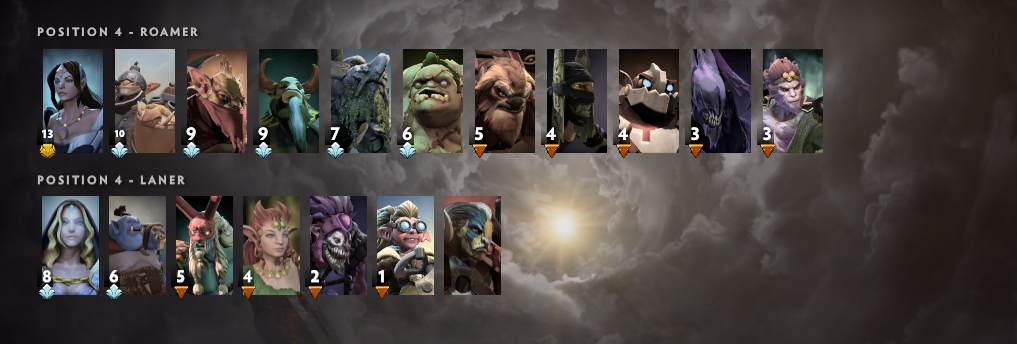
Position 4 – Support/Roamer
Common Heroes: Roaming (Pudge, Tusk, Earthshaker, Mirana), Laning (Grimstroke, Pugna, Lina, Rubick)
If you choose to play this role you need to be aware any and all success you find is based on your ability to outplay the opponents. Position 4 supports can be classified into 2 diverse roles in itself. The Roamer who applies pressure on all lanes by setting up kills and forcing enemy rotations, and the Lane support that helps out the offlane core hero. While you want to maintain a balance of these two play styles in every game, each offers pros and cons that can either enable your entire team or slow everyone down.To mess with the equilibrium consider doing one (or all) of the following:
-pull the hard camp
-stack the enemy waves
-block the small camp
-drag a creep wave behind your tower
Roaming or supporting
Roamer: Your goal is to enable your allies by either ganking their lanes, or zoning the opponents in order to create a net worth discrepancy. Just by the act of being there, you can apply pressure. Your opponents will risk taking harassment, if not feeding, in order to gain any farm.
Lane support: Your goal is to give your offlane core a good start. This can be achieved by either messing with the creep equilibrium or zoning the opponents.
The main difference between the 2 approaches is that you are either glued to 1 lane (making sure the offlane core has a good start), or you are roaming the map applying pressure, but spreading it out among the opponents.After the early game, the pos4 becomes something known as a “greedy support”. Your goal will be to enable your allies, while purchasing cost efficient items for your team. When drafting a pos4 support try to look for good synergy with your offlane core, as you will most likely be pairing up with them for the rest of the match.
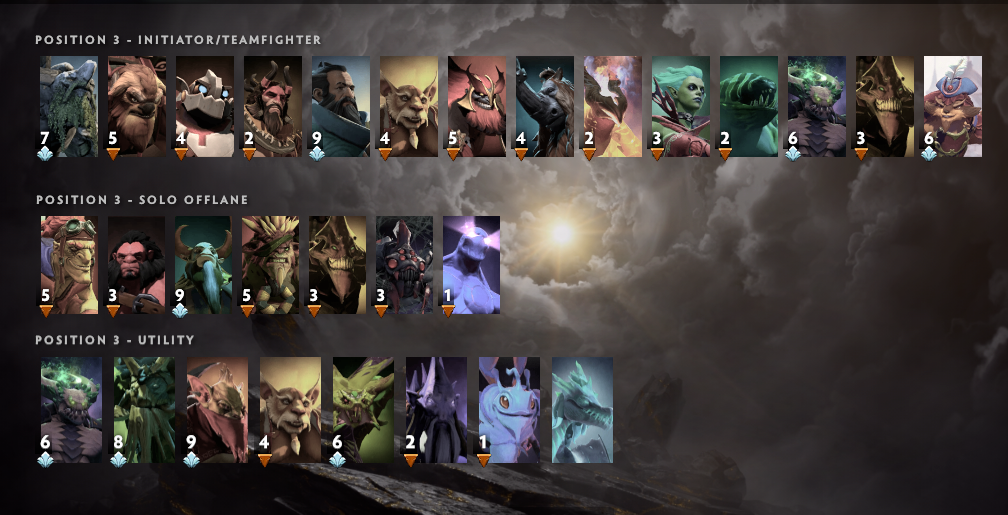
Position 3 – Offlane
Common Heroes: Mars, Timbersaw, Tidehunter, Centaur, Axe, Batrider
The offlaner should be prepared to receive a bad lane match-up. Usually offlaner’s pick 3rd, meaning the opponent’s pos1 can counter pick them. You will also be the target of ganks. Due to this, his game plan will usually be one of the following 2:
Offlane core has a good matchup
In this scenario, you are able to apply pressure on the opposing heroes, as well as increase your net worth by farming efficiently. Scenarios like this can be achieved by coordinating well with your pos4 support. When possible you should also swap lanes in order to gain favourable match-ups.
Offlane core has a bad match-up
This is the more common scenario, in which you have to utilize one very important skill, Creep cutting. That is the art of walking past the enemies Tier 1 tower (commonly between Tier 2 and Tier 3) in order to catch the wave and farm it. As there are many heroes in DOTA 2 success may vary on what you have picked. Axe and Batrider are amongst the best, as they can easily cut waves from lvl 1 even, while also farming neutral camps as well.
In the mid to late game, your job is to provide:
- initiation
- team fight
- utility
Pure farming offlane cores are rare in the current meta, as everyone wants to fight as early as possible with any lead they may have secured before. Therefore, you will want to be buying either initiation tools (blink, shadow blade), fighting items (blade mail, eul’s sceptre) or utility (vladimir’s, drums, crimson guard, mec/guardian grieves). This depends on your hero of choice as well as that particular match.
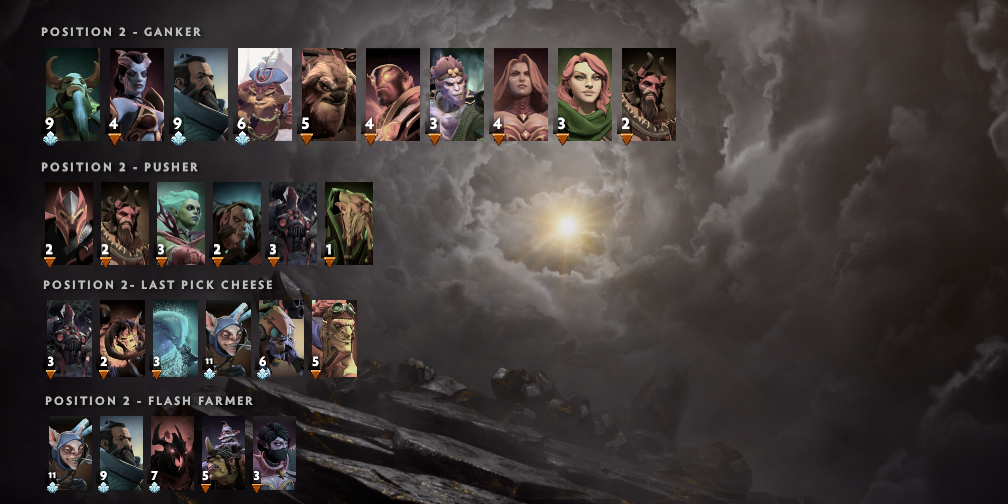
Position 2 – Mid Lane
Common Heroes: Queen of Pain, Kunkka, Invoker, Templar Assassin, Ember Spirit.
Mid used to be known as a purely 1v1 match-up of skill. The most try hard players go to brawl it out there. As mid is usually the last pick, it’s important to understand what your job will be. How you are going to accomplish that, and how the opponent may try to stop you is important to know. It’s also important to keep in mind possible “cheese” picks and anticipate them. A very common last pick hero such as Huskar can completely win games by himself. To learn how to play against Huskar we have prepared a special guide.
You’re expected to win your lane. Do not fall for this trap! “Winning” mid can mean different things.
As the Mid of the team, you’re expected to win your lane, and then help your team in making plays, killing enemy heroes and taking objectives around the map. Do not fall for this trap! You cannot win every match-up, and “winning” a lane can mean different things. Sometimes “winning” means taking an early tower, other times it’s slowing down the enemy’s farm. When playing a farming mid such as Alchemist or Naga Siren, your only job is to secure your own farm.
While it’s certainly still a match-up of skill and wit, your job as a midlaner will often be to kill the creeps as quickly as possible, and farm the nearby jungle camps. As long as the mid Tier 1 tower is alive, you will be relatively safe. Thus, keeping the tower alive for as long as possible should generally be seen as a priority. This playstyle fits heroes with AOE clear that rely on flash farm, such as Shadow Fiend, Templar Assassin and Lina.
Ganking mid
In contrast to them, heroes such as Queen of Pain, Ember Spirit and Nature’s prophet, may increase their lead by ganking the side lanes. Thus, when playing these heroes, it’s important to understand your heroes power spikes, as well as generally good times to gank.
By teleporting to another lane in order to gank, your opposing mid laner is completely free to take your mid T1 tower, if not more. You will want to preserve your Teleport scrolls. They can be used for either returning mid after a successful gank, or a trip to the fountain to restore health and mana.
Before running from mid to gank a lane, it’s important to clear the mid creeps, as this will buy you a 30s window in which you can safely gank lanes without it being too obvious. Using the Power runes that spawn in the river every 2 min after the 4min mark is also advisable. Therefore, the best time to gank may be with the 6 and 8min runes during the first night.
By either flash farming, pushing mid early, or actively ganking with your level advantage you are able to set the tempo for the game. This is called playing “fast DOTA”. By constantly keeping your enemies on their toes, and applying pressure intelligently, you can force them into inefficient plays, if not mistakes.
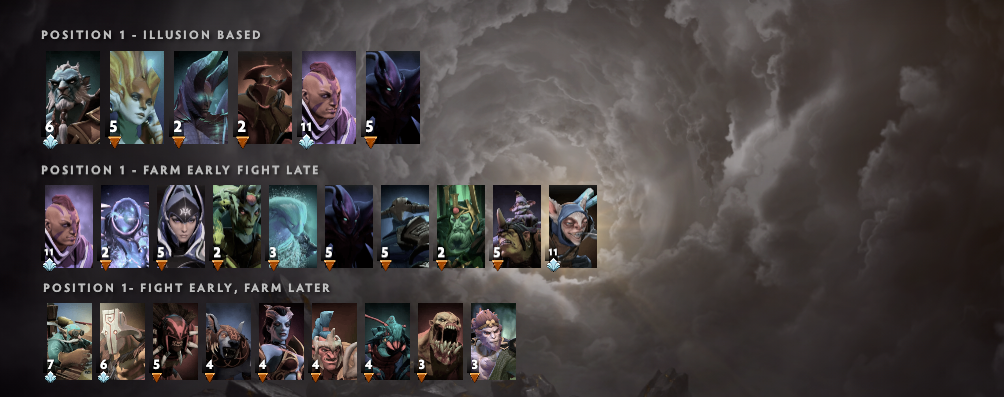
Position 1 –Safe Lane
Common Heroes: Spectre, Anti-Mage, Luna, Juggernaut, Lifestealer, Terrorblade, Lycan
Usually these are Agility right click heroes, that dish out physical damage, but there are exceptions. Heroes with strong potential will usually take this position. As each and every carry hero brings their own distinct pros and cons, it’s important to know when to pick which one, as the safelaner has the privilege of a late pick in most drafts.
On average, your job will consist of hitting lane creeps, hitting jungle creeps, and eventually, far down the road, hitting heroes and towers before winning the game. The position 1’s job is to gain as much net worth as they possibly can. You can win games by amassing gold. Thus, your decision making skills need to be on point. You must be aware of enemy movements and play accordingly. Playing with a bad position 1 is almost always detrimental to the point of no return. You will be the most farmed hero, and your mistakes are of a higher level.
Playing with a bad pos 1 is always detrimental.
Should I play Carry?
The Carry position is well suited for people who have a thorough understanding of farm efficiency, item choices, power spikes, and match-ups. It’s a very difficult role to play and constitutes a double-edged sword.
As a Carry, your team expects you to farm creeps whenever there’s space available. You’re the main investment of the lineup, which means you’re being protected in the early game. Becoming as strong as possible, and out-farming your opponents is your job. This allows you to impose your own rhythm on the game. Dictating where fights take place and around which objectives is key to not throwing your lead.
Thus, actively watching the map is a must. Be aware of enemy rotations, and play accordingly. When you are in a favourable match-up with the opposing safelaner, consider rotating there in order to apply pressure.
How does the role system work in action?
In most games of dota 2, drafts will be based around the concept of Space creation and Space consumption.Support heroes, as well as lower tier cores, will create space for the higher tier cores. In turn, the higher tier cores will consume that space to boost their farm levels and secure their timings and objectives.
The best example for this is Creep cutting as a offlaner. As mentioned before, this play is used when facing a difficult match-up, but it also affects everyone else on the map. By not playing the lane, you are allowing the opposing pos 1 carry to free farm his lane. While cutting, he will also be boosting his own farm, and creating space! Enemy supports will generally rotate in order to stop the cutting from happening, which relieves pressure from other lanes. This will cause a shift in map pressure. If left unchecked, the offlaner will quickly farm his first big item (blink dagger, mec, vanguard). With it he can enable his teammates and apply pressure on the map. If heroes rotate to stop you, your other lanes will gain power.
What role do I choose?
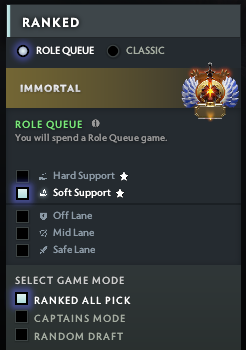
DOTA 2 is team based game and also a role based game. Understanding your role within your team and playing it to the best of your abilities will lead you towards improvement. If you want to become a better DOTA 2 player, don’t try to master everything at once. The best way to learn is to play similar roles. Pos 3 and 4 are similar. By playing 1 and 3 you can learn the same lane from both points of view. And in those roles, play 3-5 heroes until you’ve mastered them. If you want to increase your MMR, this is the surest path to success.
The main thing to remember is that a naturally strong hero will be much stronger in the right hands. So playing a few heroes until you’ve mastered them is much wiser than playing +20 heroes at a poor level.

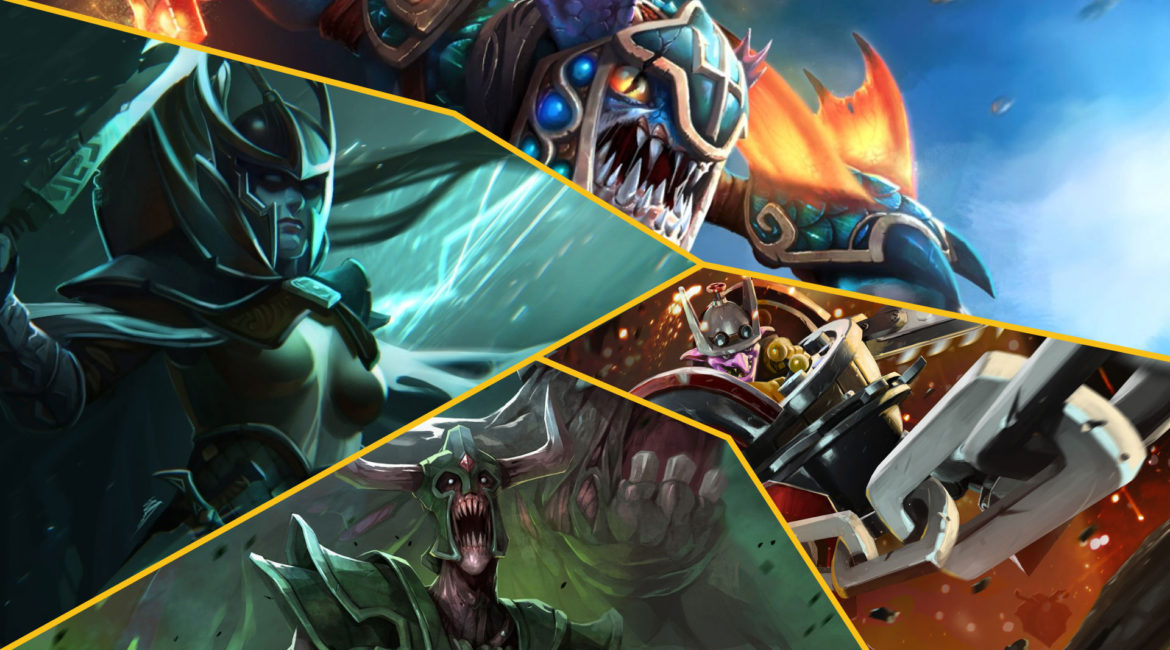




[…] your role describes your farm priority, your job is what you do with that farm. In the 3k trench, you can […]